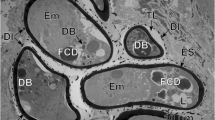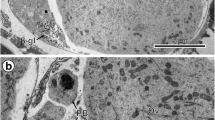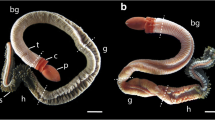Abstract
The fine structure and differentiation of the embryonic envelopes before and after hatching in two bothriocephalid species of teleostean fish are described. Scanning electron microscopic observation of the egg surface confirmed the specific ornamentation of the capsule. Its thickness and topographic morphology reflect the physiocochemical characteristics of the environment. Beneath the eggshell, two syncytial layers were observed around the oncosphere. The outer envelope, visible during the preoncospheral phase, degenerated before the liberation of the coracidium. Glycoconjugate labelling confirmed the nutritive character of this layer. After hatching, the inner envelope was the only layer covering the oncosphere. The apical plasma membrane of the coracidial sheath bore cilia and numerous clublike microvilli. Beneath the cortical zone, the syncytial cytoplasm was vacuolated, resembling a honeycomb; the electron-dense zone, described from other pseudophyllideans, was not present. The basal membrane of the inner envelope, uniformly electron-dense, was assimilated by the oncospheral membrane. Comparison of the composition of the embryonic envelopes of pseudophyllideans with those of other tapeworm orders and trematodes revealed ontogenetic, structural and functional similarities between the embryotrophic layers. The physiological and ecological significance of the structure of the free-swimming coracidium is discussed. In this respect, the inner envelope around the oncosphere appears to be responsible for the inability of the larva to detect and invade the intermediate host. Free-swimming larvae are numerous and have been extensively studied in the turbellarians (Tyler 1984) and most of the platyhelminths (Lyons 1977; Threadgold 1984), whereas they are relatively rare in the tapeworm orders, where they are found only in pseudophyllidean (Bothriocephalidae, Haplobothriidae, Triaenophoridae, Dibothriocephalidae, Cephalochylamididae and Amphicotylidae) and trypanorhynchan cestodes (Ubelaker 1983).
Despite the exceptional character of these larvae, which are further distinguished by the early release of the eggs into the outside environment, few studies have dealt with them; even fewer have focused on the embryonic envelopes surrounding the oncosphere during development in the egg and following hatching. The only studies in the literature concernDiphyllobothrium dendriticum (Grammeltvedt 1973),Spirometra mansonoides (Lumsden et al. 1974) andBothriocephalus clavibothrium (Swiderski and Mokhtar 1974; Gabrion 1981 a) and essentially concern the development of the oncosphere tegument.
During experimental studies on hatching and coracidium behavior (Berrada-Rkhami 1984), we considered the possibility of investigating the embryonic envelopes of two bothriocephalid species before and after hatching to determine their physiological and ecological significance. This was the objective of the present study, in which we also compared the structure and evolution of these embryonic envelopes with those of other platyhelminths.
Similar content being viewed by others
References
Berrada-Rkhami O (1984) Etude expérimentale du phénomène d'éclosion et du comportement du coracidium de deux espèces jumelles de Cestodes Pseudophyllides. Thèse de doctorat de 3° cycle, USTL Montpellier
Berrada-Rkhami O, Gabrion C (1986a) Etude expérimentale du développement de Bothriocéphales parasites de poissons pleuronectiformes: Influence des facteurs abiotiques sur la durée du développement et l'éclosion des larves. Vie Milieu Ser A 36:45–54
Berrada-Rkhami O, Gabrion C (1986b) Etude expérimentale des larves de Bothriocéphales parasites de poissons pleuronectiformes. Réponses motrices à des stimulations lumineuses. Vie Milieu Ser A 36:109–116
Boletsky S von (1973) Association of mitochondria with ciliary rootlets in squid embryos. Cytobiologie 8:164–167
Brand T von (1952) Chemical physiology of endoparasitic animals. Academic, New York
Burton PR (1963) A histochemical study of the vitelline cells, egg capsule and Mehlis' gland in the frog lung fluke,Haematoloechus medioplexus. J Exp Zool 154:247–258
Clément P (1977) Introduction à la photobiologie des Rotifères dont le cycle reproducteur est contrôlé par la photopériode. Thèse de Doctorat d'Etat, Université Claude Bernard, Lyon
Combes C (1980) Les mécanismes de recrutement chez les métazoaires parasites et leur interprétation en termes de stratégies démographiques. Vie Milieu Ser A 30:55–63
Cordier A (1976) Relationship between ciliary rootlets and smooth endoplasmic reticulum. Cell Tissue Res 166:315–318
Fairweather I, Threadgold LT (1981)Hymenolepis nana: the fine structure of the embryonic envelopes. Parasitology 82:429–443
Gabrion C (1981a) Ontogénèse des Cestodes Cyclophyllides. Etude morphogénétique du développement post-oncosphéral. Thèse de Doctorat d'Etat USTL. Montpellier
Gabrion C (1981b) Recherches sur l'oncosphère des Cestodes: Origine et formation de la calotte recouvrant les crochets. Z Parasitenkd 65:191–205
Grabiec S, Guttowa A, Michajlow W (1963) Structure of the ciliated envelope of the coracidium ofDiphyllobothrium latum (L.) (Cestoda, Pseudophyllidea). Bull Acad Pol Sci 11:293–294
Grabiec S, Guttowa A, Michajlow W (1964) Investigation on the respiratory metabolism of eggs and coracidia ofDiphyllobothrium latum (L.) Cestoda. Bull Acad Pol Sci 12:29–34
Grammeltvedt AF (1973) Differentiation of the tegument and associated structures inDiphyllobothrium dendriticum Nitsch (1824) (Cestoda: Pseudophyllidea): an electron microscope study. Int J Parasitol 3:321–327
Halton DW, Stranock SD, Hardcastle A (1974) Vitelline cell development in monogenean parasites. Z Parasitenkd 45:45–61
Hilliard DK (1972) Studies on the helminth fauna of Alaska: LI. Observations on eggshell formation in some diphyllobothriid cestodes. Can J Zool 50:585–592
Irwin SWB, Threadgold LT (1970) Electron microscope studies onFasciola hepatica: VIII. The development of vitelline cells. Exp Parasitol 28:399–411
Ischii Y, Miyazaki I (1970) Comparative study on the eggshell of AmericanParagonimus through the scanning electron microscope. Jpn J Parasitol 31:321–331
Johri LN (1957) A morphological and histochemical study of egg formation in a cyclophyllidean cestode. Parasitology 47:21–29
Køie M, Christensen ØN, Nansen P (1976) Stereoscan studies of eggs, free-swimming and penetrating miracidia and early sporocysts ofF. hepatica. Z Parasitenkd 51:79–90
Lambert A (1979) Oncomiracidiums et phylogénèse des Monogenea (Platyhelminthes). Thèse Doctorat d'Etat, USTL Montpellier
Lumsden RD, Oaks JA, Mueller JF (1974) Brush border development in the tegument of the tapeworm,Spirometra mansonoides. J Parasitol 60:209–226
Lyons KM (1977) Epidermal adaptations of parasitic platyhelminths. Symp Zool Soc London 39:97–144
Maejima J, Yazaki S, Fukumoto S, Kamo H (1983) Morphological comparison of eggs between marine species and freshwater species in Diphyllobothriid cestodes. Jpn J Parasitol 32:27–42
Michajlow W (1933) Les stades larvaires deTriaenophorus nodulosus (Pall): I. Le coracidium. Ann Parsitol Hum Comp 11:339–348
Olsson R (1962) The relationship between ciliary rootlets and other cell structures inAmphioxus. J Cell Biol 15:596–599
Robert F (1988) Expressions phénotypiques et stratégies adaptatives au sein du complexeBothriocephalus scorpii. (Cestoda-Pseudophyllidea). Thèse de Doctorat USTL. Montpellier
Rohde K (1968) Die Entwicklung vonMulticotyle purvisi Dawes, 1941 (Trematoda: Aspidogastrea). Z Parasitenkd 30:278–280
Rohde K, Georgi M (1983) Structure and development ofAustramphilina elongata Johnston, 1931 (Cestodaria, Amphilinidea). Int J Parasitol 13:273–287
Ruszkowski JS (1932) Etudes sur le cycle évolutif et sur la structure des Cestodes de mer: IIo partie. Sur les larves deGyrocotyle urna (Grube et Wagener). Bull Acad Pol Sci 2:629–641
Rybicka K (1966) Embryogenesis in cestodes. Adv Parasitol 4:107–186
Rybicka K (1972) Ultrastructure of embryogenic envelopes and their differentiation inHymenolepis diminuta (Cestoda). J Parasitol 58:849–863
Sato M, Sadoka M, Nakashio K, Noguchi T (1966) Electron microscopy of the egg-shell formation in the lung flukeParagonimus miyazakii. J Electr Microsc 15:286–287
Schauinsland H (1886) Die embryonale Entwicklung der Bothriocephalen Jena. Z Naturwissensch 15:520–578
Smyth JD, Clegg JA (1959) Egg-shell formation in trematodes and cestodes. Exp Parasitol 8:286–323
Swiderski Z, Mokhtar F (1984) The fine structure of the coracidia ofBothriocephalus clavibothrium Ariola, 1899 (Cestoda, Pseudophyllidea). Proceedings, ICOPA III, Munich, vol 1, sect B, pp 412–413 Facta Publication Vienne
Swiderski Z, Moser P, Eklu-Natey DT (1980) The fine structure of protective envelopes of the egg ofSchistosoma mansoni. Proceedings of the 7th European Congress on Electron Microscopy, The Hague. In: Brederoo P, De Priester W (eds) Electron microscopy, vol 2. Leiden, The Netherlands, pp 218–219
Threadgold LT (1984) Parasitic platyhelminths. In: Bereiter-Halm J, Matoltsy AG, Richards KS (eds) Biology of the integument: 1. Invertebrates. Springer, Berlin, pp 132–211
Tyler S (1984) Turbellarian Platyhelminths. In: Bereiter-Halm J, Matoltsy AG, Richards KS (eds) Biology of the integument: 1. Invertebrates. Springer, Berlin, pp 112–131
Ubelaker JE (1983) The morphology, development and evolution of tapeworm larvae. In: Arme C, Pappas PW (eds) Biology of the Eucestoda, vol 1. Academic, New York
Wilson RA (1968) The hatching mechanism of the egg ofFasciola hepatica. Parasitology 58:79–89
Wilson RA (1969) Fine structure of the tegument of the miracidium ofF. hepatica L. J Parasitol 55:124–133
Wittrock DD (1982) Structure and origin of the eggshell ofQuinquesenalis quinquesenalis (Trematoda: Notocotylidae). Z Parasitenkd 67:37–44
Yamane Y, Seki R, Okada N (1976) Comparative observations on surface topography of teguments and eggshells of diphyllobothriid cestodes by scanning electron microscopy. Yonago Acta Med 20:55–65
Yamane Y, Nakagawa A, Makino Y, Hirai K (1983)Diphyllobothrium latum: scanning electron microscopic study on the eggshell formation. Jpn J Parasitol 32:13–25
Author information
Authors and Affiliations
Rights and permissions
About this article
Cite this article
Berrada-Rkhami, O., Gabrion, C. The fine structure of the embryonic envelopes before and after hatching in bothriocephalids: physiological and ecological significance. Parasitol Res 76, 251–262 (1990). https://doi.org/10.1007/BF00930822
Accepted:
Issue Date:
DOI: https://doi.org/10.1007/BF00930822




